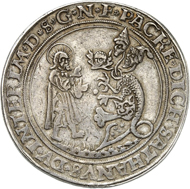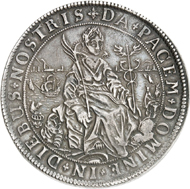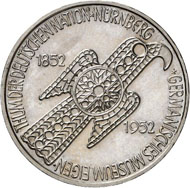22-06-2015 – 24-06-2015
Auction 263-264
28,000 Euros for the only Pattern of the artists design of ‘Germanisches Museum’
From June 23 to 25, 2015, the Steigenberger Hotel Remarque in Osnabrück was solely focusing on numismatics. Auctions 263 and 264 of the Künker auction house presented a great range of rarities, some of which originated from old and important collections, which once again proved an old saying: rare and magnificently preserved specimen yield impressive results.
Auction 263: Popken Collection – Horn Collection – Coins and Medals from Medieval and Modern Times, from Europe and Overseas
Lot 420: POPKEN COLLECTION. Magdeburg. Thick double thaler n. d. (1549) on the Augsburg Interim. Probably unique specimen. Very fine. Estimate: 4,000,- euros. Hammer price: 11,000,- euros.
Numerous rarities in the best grades possible were to be found in the Popken Collection, featuring coins from the cities of Erfurt, Halberstadt, Hamburg, Magdeburg, and Quedlinburg. As a comprehensive special collection, the Popken Collection offered lots in diverse price ranges, starting in the lower three-digits and going up to the higher five-digits. An extremely rare uniface gold freipfennig from the city of Erfurt (3, VF), estimated at 1,000 Euros, was sold for 5,000 euros. Another example is a goldgulden of the cathedral chapter of Halberstadt (97; VF; 3,000/ 6,000 euros) and a unique thick double taler from the city of Magdeburg (420; VF; 4,000/ 11,000 euros).
Lot 1086: GERMAN STATES / EAST FRISIA. Ulrich II, 1628-1648. 1 1/2 reichsthaler n. d. (1631), Esens, on his homage. Extremely rare. Very fine to extremely fine. Estimate: 20,000,- euros. Hammer price: 29,000,- euros.
Even higher results were attained by coins of the German States, coming from different collections, including specimen from the famous Horn Collection. Noteworthy examples are the pattern of an 1838 Prussian vereinsdoppeltaler minted in Berlin (718; nearly FDC; 20,000/ 22,000 euros), a 1631 1 1/2 reichstaler of Ulrich II as Count of East Frisia (1086; VF-EF; 20,000/ 29,000 euros), and a 1632 reichstaler of the city of Ravensberg (1111; EF, 12,500/ 16,000 euros.)
But also the coins of minor minting authorities offered successful biddings. An inconspicuous denarius of the Hammerstein Family, dating from the 13th century, arrived at a hammer price of 2,800 Euros (924; VF-EF), when the bidding started only at 500 Euros. For the exact same estimate a 1654 broad reichstaler, of which, according to archival records, only 120 specimen had been minted, reached a price of 3,400 euros (1101; VF.)
Nr. 1106: GERMAN STATES / QUEDLINBURG. Beatrice II of Winzenburg, 1138-1160. Bracteate. Very rare. Extremely fine. Estimate: 1,000,- euros. Hammer price: 5,000,- euros.
The current high standings of Bracteates among collectors was demonstrated by a specimen featuring the seated Abbess Beatrice II of Winzenburg (1106; EF; 1,000/ 5,000 euros.).
But also many of the lots containing a multitude of items offered surprises. For example Lot 1447, a very comprehensive collection consisting of roughly 4,650 items with an emphasis of the German States, was fiercely bid over. At an estimate of already 45,000 euros it reached a hammer price of 92,500 euros. On a percentage base, when comparing the estimate and the final bid, Lot 1448 even surpassed the latter. A collection of about 2,175 German State coins with a focus on medieval coinage from the 11th to the 14th century, the lot was called out for 35,000 euros, only to reach a staggering price of 75,000 euros.
Nr. 1730: FRANCE. Napoleon I, 1804-1814, 1815. 5 francs 1806, BB, Strasbourg. Very rare. First strike, nearly FDC. Estimate: 3,000,- euros. Hammer price: 26,000,- euros.
Currently many collectors are specializing in the Holy Roman Empire which was reflected in the biddings of the following specimen: an undated reichstaler of Ruldolph II, minted in Breslau (1473; EF; 20,000/ 26,000 euros), a 1637 thick triple reichstaler of Ferdinand II, minted in Kremnitz (1489; nearly EF; 10,000/ 28,000 euros), and a 1790 konventionstaler of Leopold II, minted in Vienna (1550; FDC; 15,000/ 22,500 euros.) But a perfectly preserved 1806 French 5 francs piece with a gorgeous patina and minted in Strasbourg, stole the show: starting at a rather modest estimate of 3,000 euros, it was at the final bid of 26,000 euros, that it finally changed hands (1730; nearly FDC).
Auction 264: Gold Coins – German Coins after 1871 – Russia
Let us stay in France a bit longer and have a look at Auction 264 with its gold coins. It came to no surprise that the selection of the French coins offered by Künker had more than one remarkable result.
Nr. 3035: FRANCE. Louis IX, 1245-1270. Dinar n. d. (1251/1254), Akko. Imitation of an Arab dinar. Extremely fine. Estimate: 2,000,- euros. Hammer price: 6,000,- euros.
Of great historical importance was the offered imitation of an Arab dinar, minted in Akko by the French King Saint Louis between 1251-1254. The final bid was as high as three times the specimen’s estimate (3035; EF; 2,000/ 6,000 euros.) Continuing, the final bid of a 1862 100 francs piece of Napoleon III minted in Strasbourg, of which only 3,078 specimen were produced, was no less than 10,500 euros, instead of its estimated 2,500 euros (3130; good EF.)
Even more impressive were the results of a large series of British 5 guinea pieces: a 1692 William III and Mary specimen (3166; EF; 20,000/ 46,000 euros), and a 1706 Anne specimen (3168; EF; 35,000/ 48,000 euros.)
The highly interesting group of high denomination gold coins from Transylvania also attracted wide interest and fierce bidding. The highest price was received for a 1577 10 ducat piece showing the crowned arms of the Bathory dynasty (3366; VF-EF; 60,000/ 58,000 euros.)
Lot 3454: HOLY ROMAN EMPIRE. Leopold I, 1657-1705. 10 ducats 1692, Vienna. Probably 3rd known specimen. Extremely fine. Estimate: 50,000,- euros. Hammer price: 130,000.- euros.
The aforementioned high demand for coins of the Holy Roman Empire was also reflected in its production of gold coins: many five-digit hammer prices were archived, which included the most expensive coin of the entire auction: a Viennese 1692 10 ducat piece of Leopold I (3454; EF; 50,000/ 130,000 euros.) And yet another Austrian piece became one of the sales biggest surprises. With an estimate of 750 euros and thus only twice its gold price, the bidding of an 1861 shooting medal of the Sixth Moravian Rifle Meeting at Mährisch-Ostrau in perfect condition rose to 45 times its original estimate: 34,000 euros! (3530; EF-FDC)
Lot 3765: GERMAN STATES / NUREMBERG. 6 ducats 1631 with title of Ferdinand II. Very rare. Nearly FDC. Estimate: 60,000,- euros. Hammer price: 80,000,- euros.
Not that many surprises, but many results in the five-digit regions were to be found among the gold coins of the German States. For example an undated (1759) Bavarian gold medal of 50 ducats of Elector Maximilian III Joseph and his wife (3578; EF; 75,000/ 75,000 euros), a 1677 bankportugalöser from the city of Hamburg (3687; EF; 15,000/ 36,000 euros), a 1661 6 ducat piece of the capture of Münster with its cityscape on view (3752; EF; 20,000/ 34,000 euros), and a 1631 Nuremberg 6 ducat piece, also featuring the cityscape (3765; nearly FDC; 60,000/ 80,000 euros.)
The great popularity of German coins was further proven by the results in the category of Imperial Coinage: on the one hand a very fine to extremely fine 1872 20 mark piece of Ernest II of Saxe-Coburg-Gotha – the rarest imperial gold coin of all – changed hands at 65,000 euros and on the other hand a proof specimen of “Frederick the Wise” reached a hammer price of 80,000 euros.
Lot 4469: FRG. Pattern 5 DM 1952 D ‘Germanisches Museum’ (‘Germanic Museum’). Schaaf – (cf. 388/G1). Beckenbauer Coll. -. Estimate: 15,000,- euros. Hammer price: 28,000,- euros.
Eagerly awaited was the final bid of the numismatically most interesting pattern showing an artist’s design for the very first (West-) German commemorative coin featuring the celebration of the “Germanisches Museum.” The estimate of 15,000 euros was soon pushed up and the hammer price arrived 28,000 euros. Being a pattern for a German commemorative coin this is certainly quite a high price, but, for example, compared to US American items of similar importance, there is still room for improvements.
You may find all results online here.
The next Künker auction will be conducted between September 26 and October 2, 2015. The relevant auction sale catalogs may be ordered at Künker, Nobbenburgerstraße 4a, D-49 076 Osnabrück; phone +49 (0)541 / 96 20 20; telefax: +49 (0)541 / 96 20 222; or via email.


















